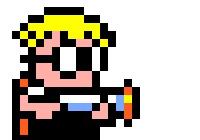Mutant Mudds Deluxe (Wii U) Review
By Javier Jimenez  15.06.2013
15.06.2013

Designing a unique platforming game today is a difficult feat. The vocabulary of the genre has become set in stone since its inception in the 1980s with Donkey Kong. Just saying the name "platformer" brings to mind concrete ideas about how the player character should run and jump.
Every once in a while we get some incremental improvement, a logical leap in the platforming design. A game like Super Meat Boy will come along and then, bang, of course, wall sliding. Makes perfect sense. Then everything, including Super Mario Bros. will have wall sliding.
It's rare, though, that some game actually steps back and looks at it all and tries something fundamentally different with the formula. For instance, instead of fast running and long jump arcs, how about meticulously precise use of a jetpack that allows hovering? Mutant Mudds is that game.
This may seem like a lot of words to say something as simple as, "well, instead of just jumping you also can hover and shoot a gun," however the entirety of Mutant Mudds' design is based on the idea of being able to hover in midair for a limited amount of time. This leads to levels that are fundamentally different in design from a game like Rayman or Super Mario Bros.
Rather than long linear levels requiring careful jumps over long gaps, you have hovering over gaps and hallways, often spike covered. Enemy placement frequently plays into hovering, requiring the player to split second hover before landing in order to blast the enemy that is hogging up a very small platform.
All of this comes with a difficulty curve that quickly increases to frustrating (in a good way) levels of challenge. While it never reaches platforming hells in difficulty, it is enough to get the brain percolating, cogitating, and thinking of how to make each little jump, where to hover and when to shoot.
Honestly, Mutant Mudds feels fresh, a nice take on what platforming is at its most fundamental level. Because the fundamentals of platforming are all there: judging gap distance and landing on small platforms. It's just that Mutant Mudds does it in such a different way.

The aesthetics of the game aren't bad either. Back in the old days™, on the NES, the idea of "childhood fantasy" was a more common motif than it is today. Games like A Boy and His Blob, Little Nemo, Blaster Master, and Monster Party all focused on the idea of a young boy setting out to fight some fantastical dream-like monsters. That's squarely Mutant Mudds falls.
In the opening scene the main character, Max, is relaxing in his living room when a meteor fully of "muddys" crashes on earth. However, like most NES games, that setup doesn't last long. It's a quick explanation of why you're blasting vaguely blob shaped brown things with a water gun. From there it's a quick jump into a vibrant green tutorial stage, and then a fast hop over to the main game, where the real work begins.

Clean is a good word to describe a lot of things about Mutant Mudds. The game's story revolves around the idea of cleaning away the muddys with a water gun. The game's art style is very "clean", nice clean, vibrant, brightly colored sprites. The game's music is very clean chiptune stuff, bouncy, hearkening back to those old NES games.
On the subject of music, Mutant Mudds deserves special mention. Every single stage of the game, all 60 stages, have a unique song. And all of them are catchy, fun, good listening. That's commendable, and it really helps to move the game along.
On the subject of the visual presentation, though, Mudds sometimes falls a little short. While the game is nicely detailed, character sprites and level tiles sometimes feel somewhat limited. And unlike the music, they are recycled often. While there's not much you can do with a brown blob shaped enemy, and while the levels do have small background touches, the flatness of some elements draws from the overall effect.
While we're talking about effects, something Mutant Mudds lost in the transition from 3DS to PC and Wii U is its 3D rendering. While the layers are still there, and the difference between layers is highlighted by a depth of field effect (the current layer is clear, the others blurred), it's not quite as impressive as it was on the 3DS.

No review of Mutant Mudds Deluxe can be concluded without mentioning the deluxe version contents.
The deluxe version of the game comes not only with the PC version's Granny CGA levels, which are in themselves great, but also 20 new ghost levels. Ghost levels are sort of the "master class" levels of Mudds. They remix old levels with new graphics, new music, and new ghost type enemies that can only be killed by a limited ammo ghost killing weapon found in each level. If the main game was not challenging enough, the ghost levels take it to the next level.
All in all, the Granny and Ghost levels double the length of the game to about 10 hours. A fair deal for the cost of entry.

Cubed3 Rating
Great - Silver Award

The ultimate question is always, "is it good?" The answer to that question for Mutant Mudds is yes, definitely. While certain aspects of its visual presentation are less than grand, and though its gameplay can sometimes be a little slow, it is something quite different and quite well executed. All in all, Mutant Mudds is a charming, challenging, fun, well-crafted game, and we recommend it.

![]() 8/10
8/10
![]() 0
(0 Votes)
0
(0 Votes)
 Out now
Out now  Out now
Out now  Out now
Out now  Out now
Out now Comments
Comments are currently disabled

 Sign In
Sign In Game Details
Game Details Subscribe to this topic
Subscribe to this topic Features
Features






 Top
Top

